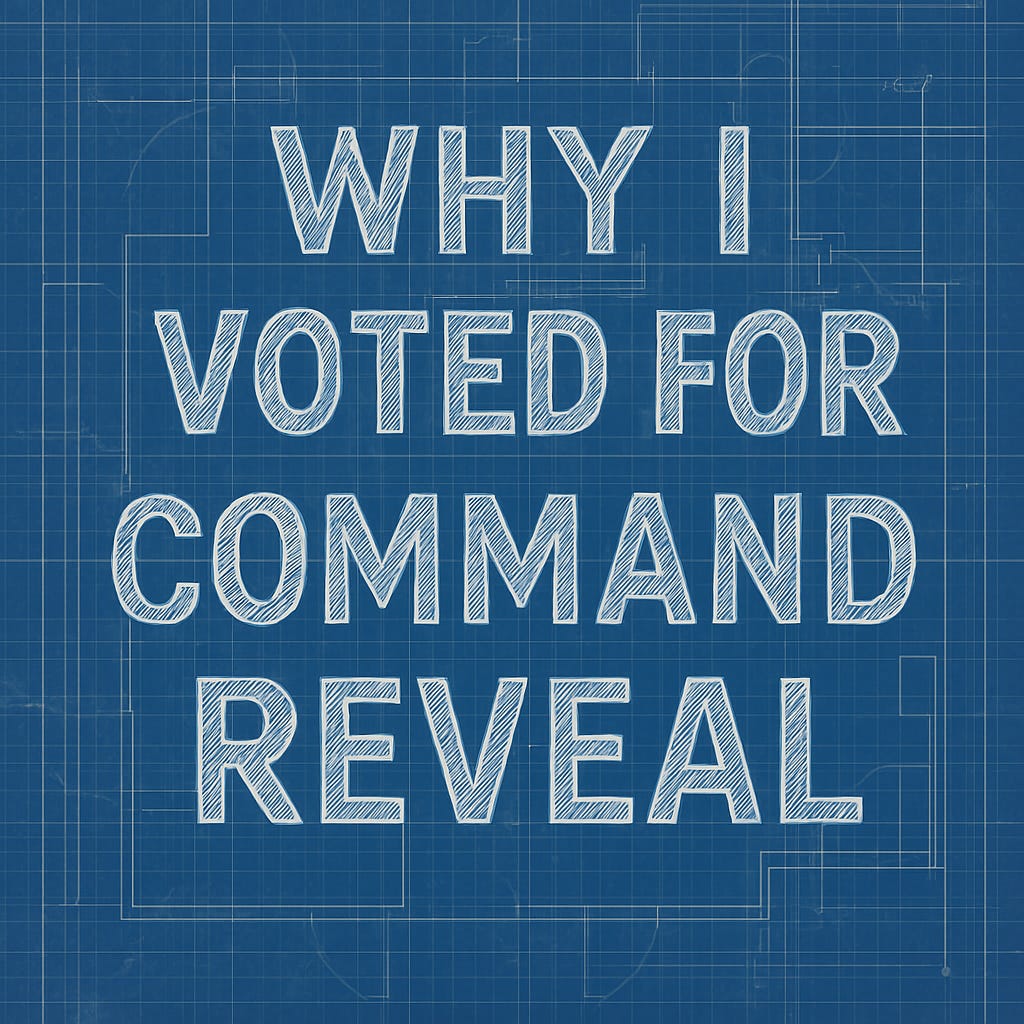This wasn’t a late-night domain grab. We did the full branding exercise. Sat with it. Dug deep. Brought in outside help.
Fiasco—our agency, and they’re brilliant—came back with so many suggestions and possible directions.
When I saw Command Reveal, it jumped off the page. I didn’t come up with it but I knew it was right. It was two words I didn’t realize I’d been circling my whole career.
My co-founder—a brilliant engineer—felt it too for his own reasons. We voted. We aligned. And that was it. Not because it sounded slick, or tested well. But because it named a deeper posture we both believed in, even if we couldn’t articulate it yet.
Command. Reveal.
Two gears. Two tensions. 1
Command is agency. Action. A clean yes or no. It’s choosing what matters before someone else chooses for you. It’s moving with weight. Not speed.
Reveal is perception. Pattern. Shape emerging from the fog. It’s what technology promises but rarely delivers. It’s the difference between data and meaning.
Not long after, I found myself scribbling quotes in my notes:
“The deeper essence of technology is a revealing.” — Heidegger 2
“Our insistence on revealing a world in terms of its order-ability to our demands, it’s accessibility to us, will inevitably be applied to us.” — Dr. James D. Madden 3
That’s the paradox — the more we try to command the world, the more we risk being reduced to the logic we use to control it.
The more we demand revelation on our terms, the more we flatten reality into what’s measurable, package-able, and push-button simple. 4
That’s not what I want. What I want is a way of moving through the world that preserves judgment, friction, and attention. Where Command is a choice born from context. And Reveal is a form of truth that doesn’t just inform—it asks something of you.
Not convenience. Not flow state. But the kind of friction that forces real choices. The kind of constraint that tells you who you are (reveals character).
Not the perfect system. But the ability to trace how and why it came to be. To know what it touches. To feel what it costs.
This is the human part of data engineering. In a field trying to widgetize everything—to templatize, orchestrate, and automate every bump out of existence—this is what remains stubbornly, beautifully human and the only path to find the true connection between data and it’s value.
Not tools. Not dashboards. Not frameworks. In between all of these things - the moments where things don’t line up—and you have to decide what matters.
That’s where the real work lives, where trust is built and where the future gets shaped.
CMD+RVL, the project, is a quiet experiment in that. What if metadata wasn’t exhaust, but architecture? What if every data engineer on your team could see the structure of your ecosystem —not just build pipelines—and feel more alive in their work because of it? What if the business could finally understand the true cost of their data decisions, and become partners in relieving—not just applying—pressure?
But even if none of that pans out—this name still holds. Because it’s not just for a product. It’s a frame.
In Seeing Structure, I wrote about how reading legacy code felt less like logic and more like cognitive archaeology. How a few naming patterns, folder structures, or a single overloaded function could tell you everything about the pressure that shaped a system.
Command Reveal came from that same pattern-recognition muscle. It gave language to what we’d been doing intuitively: Looking at systems—technical, human, organizational—and asking:
What thinking made this? And what does it want from me now?
Command Reveal has become how we check ourselves.
Are we acting with intention?
Are we perceiving with care?
Are we respecting the systems we’re inside of?
Are we tracing the pressure points—or just reacting?
We live in a time where everyone is cognitively overwhelmed. By choices. Feeds. Alerts. “Intelligence.” And what gets lost is the simple, necessary rhythm:
Command, then reveal. Reveal, then command.
To see. To move. To mean something. That’s why I voted for it. Because it didn’t just name a company. It gave words to the life style I’m trying to lead.
So here’s the challenge:
Try practicing the rhythm—today.
Rename one field in your system that no longer reflects what it actually does.
Don’t ask for permission.
Don’t debate it for a week.
Just make the move, then observe what it reveals—who notices, who breaks, what conversation it starts.
That’s the loop. That’s the practice. That’s the start. Agile is dead - wait what? - yes actually, let’s do that one in this series as well.
Happy Tuesday!
Zac
@dealcharts
https://cmdrvl.com
Field Notes on Perception is an ongoing series about how we see—systems, data, patterns, and the invisible structures that shape how we think and build. It’s a personal lens on trust, clarity, and cognition in a noisy world. Part 1 is All Code is Pressure and part 2 is Seeing Structure.
A lot more on tension to follow in future posts.
I admit I couldn’t get through Heidegger’s “The Question Concerning Technology” essay on my own. I do think I have decent reading comprehension but for this one I need other people to explain it to me. And folks interpret it differently! I tried to read a few perspectives. Gravity’s Rainbow is another example btw - I just couldn’t make it through.
Dr. Madden interpreting a part of Heidegger’s aforementioned essay in his book Unidentified Flying Hyperobject. There is something about the structure in Dr. Madden’s writing that feels trustworthy to me such that even a book about a topic as absurd as UFOs can contain commentary relevant to everyday life.
We are going to need to get into the Darren Allen stuff at some point - Quality vs Quantity - but I need to keep practicing my writing first, I am not sure I can do it justice.





